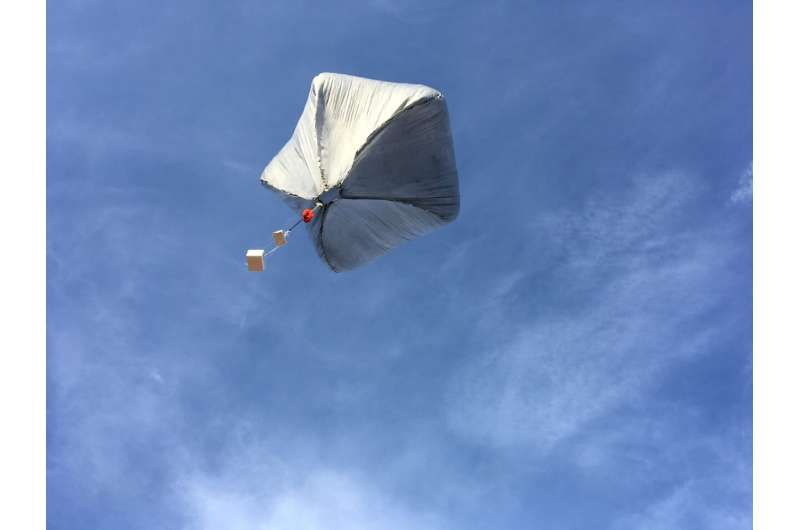This article has been reviewed according to Science X's editorial process and policies. Editors have highlighted the following attributes while ensuring the content's credibility:
fact-checked
trusted source
proofread
Beyond Bennu: How OSIRIS-REx is helping scientists study the sonic signature of meteoroids

In the high desert of Nevada, Elizabeth Silber watched NASA's Sample Return Capsule from OSIRIS-REx descend into Earth's atmosphere on Sunday, but unlike most scientists, she wasn't there for the asteroid rocks.
Silber, a physicist at Sandia National Laboratories, is working with researchers from Sandia and Los Alamos national laboratories, the Defense Threat Reduction Agency, TDA Research Inc., the Jet Propulsion Laboratory, the University of Hawaii and the Oklahoma State University in a campaign to record and characterize the infrasound and seismic waves generated by the capsule as it moved through Earth's atmosphere at hypersonic speed, about 26,000 miles per hour.
This was the largest observational campaign of any hypersonic event in history, and Silber hopes the data will improve scientists' ability to use infrasound to detect meteoroids and other objects moving at hypersonic speeds.
Scientists currently use infrasound, a low-frequency sound wave that is generally inaudible to humans, to detect and observe volcanic activity, earthquakes and explosions. Silber said infrasound can also be observed when meteoroids enter Earth's atmosphere, but atmospheric conditions like wind can distort the signal, and there's usually relatively little information available about the incoming meteoroid to help with data analysis.
"The OSIRIS-REx capsule is the perfect candidate for studying a hypersonic event because we know everything about it—the entry angle, velocity, spin rate, size and mass—and we can use that information to calibrate our models and test our sensors' abilities," Silber said.
"Because the capsule was traveling faster than the speed of sound, it generated a shockwave. As the shockwave propagated away from the capsule, it turned into infrasound waves that could be detected."
The multi-agency team launched four solar balloons and two weather balloons equipped with microbarometers in Nevada and had ground-based sensors in multiple locations.
"These are tiny little sensors that measure minute changes in air pressure," Silber said. "Infrasound is a pressure wave, and when we group sensors together in an array, we can determine the direction the infrasound is traveling from."
Silber said the group had an unprecedented number of sensors recording data, including 45 single sensors, one large rectangular array with 200 sensors, and three arrays composed of four sensors in a triangle formation. At first, the team checked to see how many sensors detected the signal. Back home in the lab, Silber and her colleagues will conduct a more extensive study.
"We want to determine where along the trajectory of the capsule the shockwave came from," Silber said. "The wave will be a continuous thing along the trajectory, so the question will be where exactly did that signal originate from? From a certain altitude? From different parts of the trail?"
The team plans to compare signals recorded from different locations in Nevada and Utah to see if they point to the same origination spot along the capsule's trail. Because the capsule's speed will change as it plunges toward the surface, moving from hypersonic to supersonic to transonic, the team will also be able to study all stages of flight.
"Moreover, we will study how strong acoustic waves propagate, test how well our instruments can capture signals and study the effects of the atmosphere on infrasound waves," Silber said. "All this will enhance our knowledge and ability to use infrasound to detect meteoroids and artificial objects with infrasound."
In preparation for this campaign, Silber, Daniel Bowman and Sarah Albert published a paper in Atmosphere reviewing past infrasound and seismic observation studies from the four other sample return missions that have occurred since the end of NASA's Apollo missions and summarizes their utility in characterizing the flight of meteoroids through Earth's atmosphere.
Silber is also leading a separate but similar Laboratory Directed Research and Development project to investigate if infrasound can be used to determine the altitude and speed of bolides—bright, exploding meteoroids—in situations when other types of sensors don't provide adequate data.
More information: Elizabeth A. Silber et al, A Review of Infrasound and Seismic Observations of Sample Return Capsules Since the End of the Apollo Era in Anticipation of the OSIRIS-REx Arrival, Atmosphere (2023). DOI: 10.3390/atmos14101473
Provided by Sandia National Laboratories




















